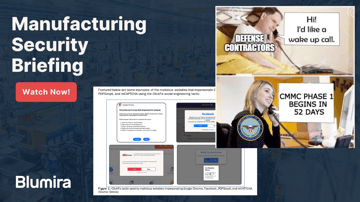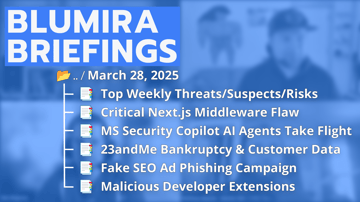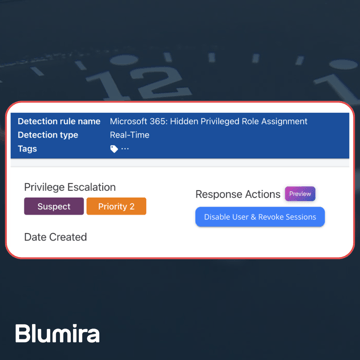- Product
Product Overview
Sophisticated security with unmatched simplicityCloud SIEM
Pre-configured detections across your environmentHoneypots
Deception technology to detect lateral movementEndpoint Visibility
Real-time monitoring with added detection & responseSecurity Reports
Data visualizations, compliance reports, and executive summariesAutomated Response
Detect, prioritize, and neutralize threats around the clockIntegrations
Cloud, on-prem, and open API connectionsXDR Platform
A complete view to identify risk, and things operational
- Pricing
- Why Blumira
Why Blumira
The Security Operations platform IT teams loveWatch A Demo
See Blumira in action and how it builds operational resilienceUse Cases
A unified security solution for every challengePricing
Unlimited data and predictable pricing structureCompany
Our human-centered approach to cybersecurityCompare Blumira
Find out how Blumira stacks up to similar security toolsIntegrations
Cloud, on-prem, and open API connectionsCustomer Stories
Learn how others like you found success with Blumira
- Solutions
- Partners
- Resources
Understanding the malware that's quietly reshaping the threat landscape, and how to protect yourself
Remember when we used to worry about viruses that just crashed your computer? Ahhh, simpler times. Malware used to almost always be loud, destructive, and frankly pretty obvious about what it was doing: monitors would flash to the blue screen of death, files would disappear, or your computer would start playing annoying sounds at random intervals.
Cybercriminals have gotten a lot smarter about their business model in the last decade since ransomware growth made malware a top earner for cybercriminals. After years of ransomware attacks grabbing headlines and threats of publicized breaches were used to leverage double payments out of victims, a recent trend shows a more subtle shift. Infostealers, the quiet, efficient threat that's climbed into the top most common malware spot in ANY.RUN’s end-of-2024 review with more than twice as many samples detected as the next most common attack (loaders), nearly 5x the frequency of ransomware, and nearly double its own rate just six months before
These attacks are insidious because victims often don't realize they've been compromised until their accounts start getting taken, which could be weeks or months later. Unlike ransomware's dramatic hostage-taking approach or traditional malware's destructive persistence, infostealers work in the shadows — and very quickly. They can slip in, grab everything valuable, and exfiltrate loads of sensitive data in seconds to minutes.
Ok, the context is admittedly pretty scary, but don’t worry: by the end of this guide, you'll understand exactly how these attacks work, why they've become cybercrime's weapon of choice, and most importantly, how to protect yourself and your network from becoming their next victim. In the second part of this article, we’ll also look at how IT and security teams can further insulate their users against becoming targets.
What Are Infostealers, Anyway?
An infostealer is malware designed with one primary goal: quietly extracting valuable information from compromised systems. If ransomware is like a victim having their vital documents held hostage until they empty their wallet, infostealers are more like pickpockets who will empty their pockets and slip away into the crowd before anyone is the wiser.
More literally, infostealers typically use a toolset of exploitation, exploration, and exfiltration to sniff out any potentially valuable data. Some of their most common targets:
- Harvesting login credentials from browsers, password managers, and applications
- Stealing cookies and session tokens to potentially bypass multi-factor authentication
- Snagging financial details like credit card information or cryptocurrency wallet details
- Exfiltrating personal information like browsing history, autofill data, and stored documents that may be used to further apply leverage to the target
- Recording keystrokes to capture passwords and sensitive information as it's typed (this is increasingly less common in favor of direct data targeting, though still included in some packages
- Monitoring clipboards to steal cryptocurrency addresses, passwords, and account numbers
- Taking screenshots at critical moments, like when users enter credentials
- Scanning file systems for documents, spreadsheets, and other valuable files
Infostealers are successful because of their modular design, where different components handle different theft missions. Some focus on browser data, others target specific applications, and advanced variants can even introduce secondary malware like remote access trojans or ransomware to set up further attacks
The key distinction that makes infostealers so dangerous? Speed and invisibility. While ransomware groups want to make their presence known (after all, victims can't pay a ransom if they don't know they've been compromised!) while infostealers are designed for hit-and-run operations. They get in, grab everything valuable, and get out, often before security systems even notice they were there.
Nano-History Lesson: From Banking Trojans to Malware-as-a-Service
Infostealers are currently having their day in the sun, but they’re far from a new tactic. The age of infostealers started with the release of ZeuS in 2006, a banking trojan that aimed to harvest client credentials. Early infostealer threats were relatively specialized, focusing primarily on financial institutions and requiring significant technical expertise to deploy.
The real turning point came in 2018 whenZeuS source code leaked, hackers swiftly copied and modified it, creating a wave of new infostealers. This democratization of malware development paved the way for the explosion of variants we see today.
Perhaps the most significant development in the infostealer landscape (and malware landscape in general) has been the rise of malware-as-a-service (MaaS) platforms allowing almost anyone to launch these once-elite attacks. Today, anyone can purchase an infostealer malware for pricing starting as low as $120 per month, regardless of their technical skill.
This fundamentally changed the cybercrime ecosystem, because cybercrime is driven by budgets and resource availability, just like any legitimate business. Previously, mounting a sophisticated infostealer campaign required specialized programming skills, infrastructure management, and deep technical knowledge – now, it’s as simple as entering (probably stolen) credit card details. MaaS transformed the threat landscape by providing the same scaling, ease-of-use, and affordability of legitimate cloud services and lowered the barriers to entry:
Pay-As-You-Grow Crime: Modern infostealer operations work just like legitimate SaaS businesses. Criminals pay monthly fees for access to malware, command-and-control infrastructure, customer support, and regular updates.The Swiss security provider Proton mentioned infostealers can be sold for as little as $120 per month.
Evil Geek Squad: MaaS platforms often include customer service, documentation, and even training materials. Some providers even offer free trial periods and money-back guarantees!
Mega-Evolution: Because these are ongoing business relationships rather than one-time sales, MaaS providers continuously improve their products.StealC combines the best features of other top infostealers with an aggressive development cycle, regularly releasing updates and improvements
They Can Go Their Own Way: Solo operators and small criminal teams can now launch campaigns that were previously only possible for well-funded criminal organizations. Since the technical complexity has been abstracted away attackers can focus on targeting and social engineering rather than malware development. This shift has created a perfect storm: more attackers with access to better tools, targeting an increasingly digital world where valuable data is everywhere.
Where Things Stand in 2025
Looking at current trends in infostealer strains, RedLine remains the veteran champion. Redline infected 9.9 million hosts, or 43% of all infostealer infections observed by Flashpoint in 2024. RedLine has held onto a top-three position since 2020, demonstrating impressive staying power in a fickle malware market. LummaC2, first released in 2022, has been making quick gains and recently earned itself a dedicated CISA advisory. RisePro, Meta Stealer, and Vidar round out the top tier – but all four still came to less than the total of RedLine!
What It Means For Individuals
When infostealers compromise personal devices, the consequences can be life-altering. Victims often don't realize the extent of the breach until accounts start getting taken over, credit cards show unauthorized charges, or they receive notifications about data being sold on dark web markets.
The stolen data doesn't just disappear—it becomes part of a criminal economy.Personal information gets packaged into "stealer logs" and sold to other criminals who specialize in different types of fraud.
What It Means For Organization
The business impact is even more severe. Notably, 46% of these were non-managed devices hosting both personal and business credentials, often linked to Bring Your Own Device (BYOD) policies. When employees' personal devices get infected, corporate credentials often get swept up in the data theft. Not to mention password re-use, where exposure of someone’s personal passwords might also expose their work data if they have used it elsewhere. While many solo operators or small teams make up the bulk of attacks, there’s still more than enough room for big players to go after high-value targets: just this month, a coordinated campaign by law enforcement in 26 countries resulted in taking down more than 20,000 malicious IPs used by one operation
How to Stay Safe
The good news is that while infostealers are sophisticated, they're not unstoppable. With the right habits and tools, you can make yourself a much harder target. Now that you understand the threat, let's talk 3 basic steps (plus one important extra credit assignment) you can take today to protect yourself:
Password Hygiene: Your First Line of Defense
Strong, unique passwords are vital to good security, and trusted password managers can be a great asset in creating them – but storing passwords directly in browsers can make them vulnerable to infostealer attacks. Instead of browser credential storage which can usually be extracted with relative ease, use a dedicated secure password manager like 1Password, Bitwarden, or KeePass that stores data in encrypted vaults. Along with storing all your existing credentials, a password manager helps you:
- Generate unique passwords for every single account, no exceptions! Password managers can effectively make this an automatic process, suggesting strong passwords whenever a new password/confirmation field set appears
- Enable two-factor authentication on your password manager itself as well as on sites that support it – also consider upgrading to passkeys for sites that support it, which relies on a more secure authentication than password-based systems. While passkeys are often tied to devices like your phone or laptop, some password managers will also store passkeys, allowing access across devices while using the stronger authentication option,
- Regularly audit your stored passwords for weak, old, or duplicate entries. This can be a tedious manual process but once again, many password managers have built-in tools to help make it easier (noticing a theme?)
Browser Security: Don’t Just Let the Data Faucet Leak
Remember earlier in the article when I said “stealing cookies and session tokens to potentially bypass multi-factor authentication” as one target infostealers go after? Yeah, about that… you can reduce the risk of session theft by setting your browser to clear cookies and browsing data automatically when you close it, and log out of important accounts rather than relying on "remember me" features. Some other good hygiene measures are disabling automatic downloads and requiring confirmation each time, take the time to pause before clicking “ok” on browser permission requests, since malicious browser extensions are a common vector for attack. As are zombie extensions: once-legitimate but abandoned tools that behind an installed user base ripe for targeting, so remove extensions you no longer actively use and make sure you’re installing security updates as soon as they’re available.
(Oh, and avoid pirated content: maybe you wouldn’t download a car, but the chances of accidentally downloading an infostealer along with the latest cracked DLC are much higher.)
Too Many Phishes In The Sea
One common trait across all malware variants is needing some way to get onto the target device, or at least deliver a script that will quietly assemble the malware itself – like an assassin mailing themselves the parts for their weapon to assemble on-site. Email remains a primary attack vector, so developing good email habits is essential. Pay extra attention to any unusually urgent requests, unexpected attachments, or links that show a different URL than the supposed sender when hovering over them. Remember, if you’re ever in doubt whether an email from a vendor or contact is legitimate, taking the time to double check through a different channel will end up saving you a lot of time remediating later. And if you do get a suspicious email, be a good neighbor and let your IT/security team know: if you’ve been targeted, there’s a chance your colleagues may be as well!
What to Do If You Think You're Infected
Having a plan for preventing being a target is good, but as we know no amount of preparation can make you immune to risk, so having a plan for what you might do if you ARE targeted is better. Here’s some good places to start:
- Stop the bleeding and disconnect from the internet immediately to prevent further data theft
- Change passwords for all important accounts from a different, clean device (if you’re using a password manager, you can even flag your important accounts in a category to keep track of them!)
- Check your financial accounts for unauthorized transactions as well as whether your providers support any additional security measures to verify your identity
- Enable account monitoring and strongly consider freezing your credit with credit bureaus – something I encourage everyone to do anyway!
- Keep records of your efforts and consider filing a police report – this will likely be necessary if you need to dispute charges or make an insurance claim
Remember: Acting quickly can minimize the damage. The longer an infostealer has access to your system, the more data it can steal.
Moving Forward: Where Do We Go From Here?
Understanding infostealers is just the first step. These threats are real, they're growing, and they're targeting everyone, not just big corporations or high-value individuals. But you're not powerless against them, and knowing is half the battle to keeping yourself safe.
The habits we've discussed, like using password managers, securing your browser, being cautious with emails and downloads, are useful for deterring potential infostealer attacks. And these habits will pay dividends, as they are also good practices to protect against most other malware attack methods, too.
In our next article on infostealers, we'll dive deep into how organizations can build comprehensive defenses against infostealers to protect their teams, covering everything from endpoint protection to threat intelligence integration and behavior-based detections. But the individual protections we've covered here form the crucial foundation that makes all other security measures more effective, and can help anyone whether they’re at home or the office.
Like that other kind of “silent but deadly” threat, infostealers can make life distinctly unpleasant and they're not going away anytime soon. But with awareness, good habits, and the right tools, you can make sure they don't get their hands on your valuable data. Stay vigilant, stay updated, and until next time – stay safe out there!
Zoe Lindsey
Zoe Lindsey is a Security Strategist at Blumira with over a decade of experience in information security. She began her infosec career at Duo Security in 2012 with a background in medical and cellular technology. Throughout her career, Zoe has advised organizations of all sizes on strong security tactics and...
More from the blog
View All Posts
Webinar
1 min read
| September 8, 2025
Video: Manufacturing Security Briefing
Read More
Security Trends and Info
4 min read
| March 28, 2025
Introducing Blumira Briefings: Your Weekly Security News Download! 🔔
Read More
Blumira News
4 min read
| March 26, 2025
Blumira Launches New Microsoft 365 Threat Response Feature for Faster and More Efficient Security Operations
Read MoreSubscribe to email updates
Stay up-to-date on what's happening at this blog and get additional content about the benefits of subscribing.